Of Flying Boats, Hot Summers and The Short Sandringham
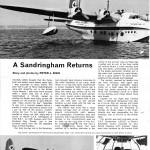 Reefing through piles of books and articles collected by late father I was intrigued to find a copy of an article published in the November 1976 Air Pictorial magazine on a flight taken in 1976 aboard a Sandringham flying-boat that had come for a visit to Britain. Being a fan of flying boats, especially the large ones, from a very early age I was thrilled to find this bit of history. I like many other kid used to collect stamps. My uncle, being an airline pilot and a lot of my parents friends and of course relations various would regularly write to us so we soon built up a very respectable collection. The old chap a few doors down, a Mr Meadows, worked for the Foreign Office during the days of the Empire and he too had a fine collection. Once every so often I would wander round on a Sunday afternoon and he would tell me the history of the stamps and countries they had come from. One day he showed me a couple of very discoloured envelopes addressed to him when he was a civil servant in India. He told me they had been aboard an Imperial Airways Flying Boat that had sunk alongside its moorings and the mail, including his letters, had been rescued. Very occasionally he would have to return to London at short notice and would travel by Empire flying boat. I though this the most fantastic adventure. Then, when I was eight, we went on holiday to the Isle of Wight and my dad took us to see the Princess Flying Boat that was mothballed. It was massive. Ever since I have always had a fascination for the flying boat in all its guises and one day I’ll get to go in one, a Sea Otter in Alaska would be perfect but I digress. Now what was so intriguing was that the article was written by none other than Zebedee’s Pete Bish.
Reefing through piles of books and articles collected by late father I was intrigued to find a copy of an article published in the November 1976 Air Pictorial magazine on a flight taken in 1976 aboard a Sandringham flying-boat that had come for a visit to Britain. Being a fan of flying boats, especially the large ones, from a very early age I was thrilled to find this bit of history. I like many other kid used to collect stamps. My uncle, being an airline pilot and a lot of my parents friends and of course relations various would regularly write to us so we soon built up a very respectable collection. The old chap a few doors down, a Mr Meadows, worked for the Foreign Office during the days of the Empire and he too had a fine collection. Once every so often I would wander round on a Sunday afternoon and he would tell me the history of the stamps and countries they had come from. One day he showed me a couple of very discoloured envelopes addressed to him when he was a civil servant in India. He told me they had been aboard an Imperial Airways Flying Boat that had sunk alongside its moorings and the mail, including his letters, had been rescued. Very occasionally he would have to return to London at short notice and would travel by Empire flying boat. I though this the most fantastic adventure. Then, when I was eight, we went on holiday to the Isle of Wight and my dad took us to see the Princess Flying Boat that was mothballed. It was massive. Ever since I have always had a fascination for the flying boat in all its guises and one day I’ll get to go in one, a Sea Otter in Alaska would be perfect but I digress. Now what was so intriguing was that the article was written by none other than Zebedee’s Pete Bish. 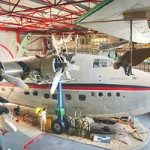 I called him up. Yes it was him and apparently it turned out that in order to get rides in aircraft various, still a passion of his (and Team Zebedee), he wrote articles for various magazines and sold himself as a journalist. Brilliant thinking. The flight itself he informed me was during the long hot summer of ’76, on the 25th August to be exact, and cost them £25 a head. This old flying boat last flew in 1981 having been stored for three years in Puerto Rico arriving in Calshot on February 2nd 1981 and now resides in the Solent Sky Museum and, yes, Pete has been to visit it and sat in the cockpit.
I called him up. Yes it was him and apparently it turned out that in order to get rides in aircraft various, still a passion of his (and Team Zebedee), he wrote articles for various magazines and sold himself as a journalist. Brilliant thinking. The flight itself he informed me was during the long hot summer of ’76, on the 25th August to be exact, and cost them £25 a head. This old flying boat last flew in 1981 having been stored for three years in Puerto Rico arriving in Calshot on February 2nd 1981 and now resides in the Solent Sky Museum and, yes, Pete has been to visit it and sat in the cockpit.
A Sandringham Returns – Story and Photos by Peter J Bish
 Having long thought that the flying boat era ended some twenty years ago, I was surprised to learn earlier this year that a pair of of Short Sandringhams were still airworthy out in the British Virgin Islands. I was even more amazed when I heard that one of them, a Sandringham 4, VP-LVE, owned by Antilles Air Boats, was flying across the Atlantic for the summer to give enthusiasts “rides round the bay’. Needless to say, not a moment passed before I started to make enquires to ensure that I got my feet off the ground (water!) during her tour. To my delight I succeeded in doing just that, along with a bunch of of fellow CAA collegues, at 1700 BST on 25th August 1976 and from Studland Bay, Dorset, just a few hundred yards from the old seaplane base at Poole Harbour.
Having long thought that the flying boat era ended some twenty years ago, I was surprised to learn earlier this year that a pair of of Short Sandringhams were still airworthy out in the British Virgin Islands. I was even more amazed when I heard that one of them, a Sandringham 4, VP-LVE, owned by Antilles Air Boats, was flying across the Atlantic for the summer to give enthusiasts “rides round the bay’. Needless to say, not a moment passed before I started to make enquires to ensure that I got my feet off the ground (water!) during her tour. To my delight I succeeded in doing just that, along with a bunch of of fellow CAA collegues, at 1700 BST on 25th August 1976 and from Studland Bay, Dorset, just a few hundred yards from the old seaplane base at Poole Harbour.
Our boat journey out to the Sandringham brought back obvious memories to the older members of our party while those of us that had never experienced a proper seaplane flight before got a good impression of what it must have been like years ago setting off for the other side of the world in such aircraft. Our motor-launch pulled alongside the doorway on the port forward side of the hull and with both us and the aircraft bobbing up and down with the tide we made our way slowly inside.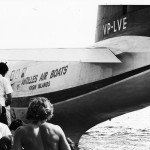
The interior was more like a plush railway carriage than an airliner, with several compartments each seating 6-10 passengers. Everywhere was very spacious, with large panoramic windows. Access to the compartments was via an aisle up the portside of the hull. An upstairs lounge at the rear had a more conventional layout and was reached by a twisting staircase in the centre of the aircraft. Also up there was a galley and an exit to the bare inside tail section where a small wooden boat was tied down, presumably a vital part of the safety equipment. Another exit in the cabin roof reached by the metal ladder led to a good platform for some photography on the outside rear fuselage!
The cockpit, reached by a ladder from the front entrance, was again very roomy, but looked somewhat dated. Lying on a shelf were the aircraft’s logbooks recoding all the flights since the mid-1950s, much of it on the Sydney to Lord Howe Island route with Ansett. Captian for our flight was Charles Blair, a dedicated flying-boat man who as a former Pan Am skipper still holds several trans-Atlantic records for flying-boats. He is now the President of Antilles Air Boats based in the British Virgin Islands and was responsible for this nostalgic visit of VP-LVE to the British Isles.
 The aircraft was built originally as an RAF Sunderland (JM715) at Short’s Rochester works powered by four Bristol Pegasus XVIII engines. These were later replaced by the current Pratt & Whitney R-1830 Twin Wasps prior to conversion to a civil Sandringham at Short’s factory at Belfast Harbour. JM715 became ZK-AMH and was deliverd to TEAL in New Zealand in 1947. Some three years later she was sold to Ansett Airways, Australia as VH-BRC “Beachcomer” where she remained until 1974 far outliving all her relatives around the world.
The aircraft was built originally as an RAF Sunderland (JM715) at Short’s Rochester works powered by four Bristol Pegasus XVIII engines. These were later replaced by the current Pratt & Whitney R-1830 Twin Wasps prior to conversion to a civil Sandringham at Short’s factory at Belfast Harbour. JM715 became ZK-AMH and was deliverd to TEAL in New Zealand in 1947. Some three years later she was sold to Ansett Airways, Australia as VH-BRC “Beachcomer” where she remained until 1974 far outliving all her relatives around the world.
Antilles Air Boats then rescued VH-BRC and her sister-ship VH-BRF from almost certain scrapping and ferried them both back to St Croix in the Virgin Islands . “Beachcomber” became N158J for the ferry flight, thence to her current VP-LVE with the name “Southern Cross”. And so with yet more regular flying behind her about the islands, VP-LVE returned to Britain for the first time in 29 years when she arrived at Belfast Harbour from the Shannon River on 21st August 1976 for a one hour enthusiasts’ flight arranged by Short’s personnel.
Our Flight
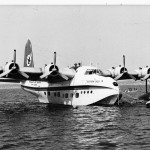 Our flight was also to be one hour long. As we taxied out to the take-off area each engine was checked and with no brakes to restrain the aeroplane, each check produced a a sudden surge forward. Full power was applied and with a crescendo of piston-engined roar we sped off amid a great wall of spray which seemed to cover most of the aeroplane. With our full load of 42 passengers plus four crew aboard, the take-off run was certainly a long one, but slowly we lifted from the water, at first just skimming the wave tops, then just a few feet above them. A cheer went up from all onboard as we built up speed towards the Hampshire coastline.
Our flight was also to be one hour long. As we taxied out to the take-off area each engine was checked and with no brakes to restrain the aeroplane, each check produced a a sudden surge forward. Full power was applied and with a crescendo of piston-engined roar we sped off amid a great wall of spray which seemed to cover most of the aeroplane. With our full load of 42 passengers plus four crew aboard, the take-off run was certainly a long one, but slowly we lifted from the water, at first just skimming the wave tops, then just a few feet above them. A cheer went up from all onboard as we built up speed towards the Hampshire coastline.
The flight took us along the coast from Christchurch to Littlehampton (passing Lee-on-Solent. Portsmouth and Thorney island) and returned along the southern edge of the Isle of Wight (passing Bembridge and The Needles) and then inland to Hurn, where, much to everyone’s delight, we completed a low approach and overshoot to Runway 26. Our cruising height never exceeded 1,000 feet and our airspeed was about 120 knots. The general impression while airborne was of effortless flight, just a gentle throb from the Wasps and a very smooth ride.
For most of the flight we had Piper Aztec G-AZXG formulated on our starboard wingtip busily filming for Southern Television and to our surprise we were joined for a while by the Supermarine S.5 replica (G-BDFF). How wonderful it was to have two proper marine aircraft together in England!
The landing was as exciting as the take-off, lower and lower over the water (at a high approach speed it seemed) until, as if ice was breaking beneath our feet, the hull touched the water. The noise increased until quite a dramatic “reverse thrust” effect stopped us in a cloud of spray as the hull settled again below the water-line.
Our trip was over. 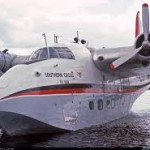 All we could do was talk about our experience as the launch took us back to the jetty. The most obvious question asked was, “Why were all those lovely flying-boats broken up in the fifties?” Imagine the business a tour operator would be doing now if he could offer a Mediterranean “cruise” by Sandringham!
All we could do was talk about our experience as the launch took us back to the jetty. The most obvious question asked was, “Why were all those lovely flying-boats broken up in the fifties?” Imagine the business a tour operator would be doing now if he could offer a Mediterranean “cruise” by Sandringham!
http://www.youtube.com/watch?v=qSZ4gS-wt2U VH-BRC in its Ansett colours taking off from Sydney Harbour Australia sometime during the early seventies. Brilliant.
http://www.solentskymuseum.org/ go to ‘museum’ and then click on ‘exhibits’ and half way down is a comprehensive summary of its career.
http://www.aussieairliners.org/books/memory%20ct%20books/vh-brc/vh-brc.html
Book all about Beachcomber called appropriately enough ‘Beachcomber-Story of a Flying Boat’.